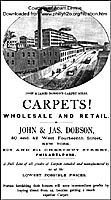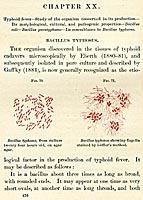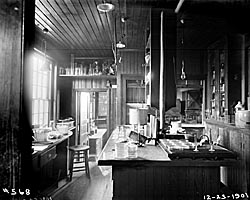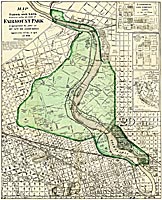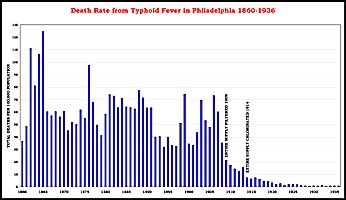
An Exhibit Celebrating 100 Years of Water Filtration
Philadelphia Water Department
Fairmount Water Works Interpretive Center
November 8, 2009 to February 7, 2010
In this online exhibit, all text and captions from the original exhibit are included, but all images are not. A number of images were provided to us from other institutions, and we do not have permission to post them on the Web. Where I was able to find the same images posted elsewhere, I have included a link below. In other cases, I have found alternate images (either online or in the PWD Historical Collection) for which a link is also provided. Anyone interested in any of the images not provided below (of particular interest to me are those from ca. 1900 water filter brochures housed at the Library of the College of Physicians of Philadelphia) should contact me, and I can make arrangements for you to see them.
Other pages on PhillyH2O contain both information and images related to the topics covered in the exhibit. In particular, this page has beautiful high-resolution photographs showing some of the construction work undertaken in the early 20th century to create both the filter plants and the distribution system needed to bring pure water to the entire city. Many other pages (this one, for example) detail the pollution of the city's rivers, which led to the public outcry that resulted in the building of the filtration system.
For more information about the Fairmount Water Works Interpretive Center (including hours and directions) click here.
For more information about the images, the exhibit, or water filtration in general, contact me. If I can't answer your questions, I will put you in touch with someone who can.
The History of Philadelphia's Watersheds and Sewers
Historical Consultant
Philadelphia Water Department
CONTENTS
Click on these links to jump to any section; once in
that section click on the heading to come back to the top of the page.
1. Workshop of the World
2. Polluted Water Spreads Disease
3. The Debate: Filtration vs. Aqueducts
4. The Solution: Slow Sand Filtration
5. Environmental Challenges
in the 21st Century
Exhibit Credits
INTRODUCTION
The industrial revolution and indoor plumbing brought polluted
water and disease to 19th-century Philadelphia. Accustomed to utilizing
the Schuylkill and Delaware Rivers as the city's water supply, the Philadelphia
Water Department undertook a building project of previously unknown proportions
to create filtration plants that would make the polluted waters safe to
drink. In 2009, Philadelphia celebrates
100 years of delivering filtered drinking water to all residents of the
city.
By 1800, Philadelphia had suffered a series of deadly yellow fever epidemics, mistakenly blamed on the polluted well water. In 1801, the city turned to the pristine Schuylkill River as the new water supply and built a small pumping station along its banks. In 1815, a much larger station was built at Fairmount, and it was joined by the Spring Garden Water Works in 1844 and another station in Kensington, on the Delaware, in 1851.
Around the time of the Civil War, the needs of an exploding population and bustling industry began to strain the city's water system. Between 1860 and 1890, Philadelphia's population almost doubled, growing from 565,529 to 1,046,964. In this same period, the city produced an impressive array of goods in hundreds of factories, employing thousands of men, women, boys and girls. Factories located alongside the city's two rivers and their many tributary streams also used the flowing water as a convenient drain for their wastes - the same rivers that provided drinking water to the citizens. To serve the needs of homes and businesses not directly next to the streams, the city built hundreds of miles of underground sewers to carry waste into the nearest streams. All of this waste was dumped with no disinfection or other treatment.
As harmful as industrial pollution can be, it was the human waste entering
the drinking water supply that led to repeated epidemics of water-borne illnesses,
particularly typhoid fever. Before a solution was adopted, thousands of Philadelphians
would die and many more thousands sickened from drinking polluted water that
came out of their taps. By the late 19th century, the city would face a public
health crisis as serious as that posed by yellow fever, but this time the
problem truly was in the water.
Captions and Illustrations for Section 1

(PWD Historical Collection; base map of 1854 from Philadelphia
City Archives;
dates of pumping stations from Curatorial Dept., The Franklin Institute
Inc.)
As the city grew, so did its water needs. This map, which shows the municipalities
incorporated into the city in 1854,
is overlaid with the locations of all the pumping stations providing water
for the city since 1801.
An 1857 bird's eye view of Philadelphia (with the Schuylkill
River in the foreground) shows a city bursting beyond its original boundaries.
In 1854, the original city (marked in green on the map below) and 28 other
Philadelphia County municipalities were consolidated under one city government.
(Library
of Congress)
As with the Fairmount Water Works, pumping station architecture often reflected
the high style of the period. The original Spring Garden Water Works (1844),
was built in the Egyptian Revival style. (Library
Company of Philadelphia)
The city couldn't expand its infrastructure and builders couldn't build new
houses fast enough to accommodate all the new immigrants to the city between
1860 and 1890, resulting in overcrowding in many sections of the city.
1. A bustling scene at Front and Market streets in 1881. (Free
Library of Philadelphia, Print & Picture Collection)
2. An immigrant family around 1900, living in cramped quarters.(Center
for the Study of the History of Nursing, Univ. of PA)
Above: By the second half of the 19th century, Philadelphia was one of the largest textile manufacturing cities in the world. This 1877 Hexamer insurance survey of the Dobson textile mills in Philadelphia's East Falls section details the specific use of each building. Note the stream marked "waste water" flowing into the factory and out the "tail race," which emptied dyes and chemicals directly into Dobson's Run, a Schuylkill River tributary located about six miles above the Fairmount Water Works. The three mills employed 380 men, 117 boys, and 143 girls. By the end of the 19th century 700 textile firms employed 60,000 residents, representing only a quarter of the city's total manufacturing workforce.
2. Polluted Water Spreads Disease
In the years between 1860 and 1909, more than 27,000 Philadelphians died of typhoid fever, a highly contagious disease caused by the microscopic bacterium Salmonella typhi. Today we understand that typhoid spreads readily through contaminated food and water supplies, and through direct contact with an infected person. The bacteria are transmitted most commonly through the fecal-oral route, so excrement from an infected person discharged directly into water supplies can infect a person who drinks that water.
In the nineteenth century, health professionals began noticing geographical
clusters of diseases incidence which gave new insight into how they spread.
An early and influential example was an 1854 cholera outbreak in London, the
source of which physician John Snow traced to a single public well polluted
by the wastes of a cholera patient.
In spite of such evidence, there was no consensus in professionals' understanding of the mechanics of disease transmission. Not until the 1880s were the bacteria that caused typhoid fever and a number of other diseases first isolated and identified with the aid of powerful microscopes. At that point, large numbers of physicians began to accept the ideas that these bacteria were the cause of disease-the so-called "contagionist" point of view.
With this mounting evidence, health professionals in Philadelphia began to link the transmission of diseases such as typhoid fever and cholera to the city's water system. "Anticontagionists" cited the clarity of water, witnessed by the naked eye after it had undergone gravity settling, as testimony of its purity. But their point of view became more and more marginalized as evidence mounted for spread of disease by microscopic germs. By the end of the 19th century, the polluted nature of Philadelphia's water supply was obvious, and the only question was the method that the city would use to obtain a pure water supply: filtration or aqueducts.
Captions and Illustrations for Section 2
Two views of bacteria.
1. In an advertisement for "McConnell Germ-Proof" water filters,
the magnified microscopic organisms are illustrated as insects, complete with
cartoonish faces. (Library of the College of Physicians of Philadelphia)
2. Below left: A more accurate view of the typhoid bacteria, from a
1905 medical textbook by University of Pennsylvania professor A.C. Abbott,
M.D. (PWD Historical Collection, from The Principles of Bacteriology,
by A.C. Abbott, M.D. Seventh Edition. Philadelphia: Lea Brothers & Co.,
1905. )
Below center: A laboratory in the Philadelphia Water Department's Spring Garden Testing Station, 1901, where experiments on water filtration were conducted.
Two views of the Schuylkill River.
1. Above right: In an effort to protect the purity of the water supply,
the city purchased land on both banks of the Schuylkill, beginning in the
1840s and culminating in the creation of Fairmount Park in 1868. (Courtesy
of Adam Levine)
2. Unfortunately, the city found it difficult to control pollution of the
river beyond its borders, as indicated on this map from a mid-1890s water
filter sales brochure. The front of the same brochure features Louis Pasteur,
a pioneering bacteriologist, who lent his name to the filter and was likely
a partner in the company. (Library of the College of Physicians of Philadelphia)
Nine visiting nurses ready for work, ca. 1909. In the 19th and early 20th centuries, patients with typhoid fever and other contagious diseases were often treated at home, not in hospitals. For those who could not afford doctors, the Visiting Nurse Association of Philadelphia offered care. (Center for the Study of the History of Nursing, Univ. of PA)
3. The Debate: Filtration vs. Aqueducts
In 1860, when the Philadelphia Board of Health began tracking causes of death, typhoid fever was among the city's leading killers. Cholera is often wrongly cited as the most deadly of various waterborne diseases, but its epidemics were episodic, while typhoid was consistently deadly. Between 1860 and 1890, cholera killed roughly 1,000 Philadelphians (most of these in a single epidemic in 1866). In the same period, typhoid fever killed more than 16,000. For each person who died from typhoid, roughly ten to fifteen more became ill but did not die, meaning that the disease ultimately afflicted hundreds of thousands of people.
Not surprisingly, the physicians who treated all these sick and dying patients were among the first to suggest that a purer water supply might reduce incidence of disease. Their call was echoed by city-sponsored water commissions in 1875 and 1886, both of which recommended abandoning the city's two polluted rivers for purer upstate water delivered by aqueducts to Philadelphia. Alternatively, by the 1890s, several European and American cities had built successful filtration plants, and this was increasingly seen as a cheaper but still viable solution to the city's water woes.
In the 1890s Philadelphia resident Frank J. Firth, a long-time proponent of filtration, organized more than 70 organizations (including many physicians' groups) into the City Organizations Filtration Committee, which lobbied the City Councils to fund filtration. The Women's Health Protective Association, another advocacy group, invited knowledgeable scientists and engineers to the city to speak about the water issue and to propose solutions. Convincing City Councils was no easy task, and their continued inaction through the 1890s promoted a number of private firms (some of them well-intended, others mere get-rich-quick schemes for their backers) to offer their solutions. Some Councilmen, stuck on the antiquated "anti-contagionist" view, remained unconvinced that bacteria were indeed deadly. One thing was clear: a solution to the city's water problem was going to cost millions, and then as now, getting elected officials to agree to such a large expenditure was a drawn-out and laborious process.
In 1896, John C. Trautwine, Jr., chief engineer of the Water Department, came close to receiving Council's approval for an experimental filtration plant, but the idea was defeated when some councilmen complained that it would be unfair to provide filtered water for one neighborhood while others had to suffer with the polluted variety. Finally, in 1899, under the leadership of newly-elected Mayor Samuel H. Ashbridge, consensus was reached. The Mayor appointed a new water commission, which recommended filtration as the best alternative. In 1900 Councils finally acted, appropriating funds to build five filtration plants and construct the water mains necessary to deliver filtered water from both rivers to all parts of the City.
Captions and Illustrations for Section 3
The city's failure to prevent polluted drinking water boosted the sales of individual water filters, shown in this mid-1890s "Keystone Filter Company" brochure. (Library of the College of Physicians of Philadelphia)
In 1898 the Philadelphia and Pennsylvania Boards of Health published a picture book, Sources of Pollution--Schuylkill River, which documented this outhouse near Pottstown, built on a bridge over a tributary to the Schuylkill River. Besides outhouses, household sewage and industrial waste poured into both the Delaware and Schuylkill rivers from towns upstream of Philadelphia, despite the city's best efforts to prevent it. (Germantown Historical Society, Philadelphia, PA)
The filtration debate involved several factions, including
politicians, medical experts, engineers, and citizen advocates.
These men were a few of the key players.
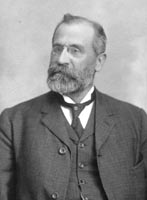

Left: Rudolph Hering, a noted consulting sanitary engineer who
began his career with the Philadelphia Water Department,
headed two city-sponsored water commissions; the second, in 1899, recommended
filtering the supply.
(PWD Historical Collection, Courtesy of Anita Guevara)
Right: John C. Trautwine, Jr., the Water Department's chief engineer
in the late 1890s, was a strong advocate
for water filtration and water conservation. (PWD Historical Collection)
James P. McNichol was a state Senator from Philadelphia and a leader of the city's ruling Republican party. His brother Daniel's construction firm received many city contracts, including major work on Torresdale and several other filtration plants. (Free Library of Philadelphia, Print & Picture Collection)
A.C. Abbott, M.D., director of the laboratory of hygiene at the University of Pennsylvania, was one of many influential medical professionals to push the city to adopt filtration. (University of Pennsylvania Archives)
Samuel H. Ashbridge was Mayor in 1900 when City Councils finally approved the construction of a water filtration system for the city. (Free Library of Philadelphia, Print & Picture Collection) ((Link to other page with Ashbridge photo)
Thomas Meehan, horticulturalist, editor, and influential City Councilman, delayed the adoption of filtration with his assertion that many bacteria were beneficial, and that the filters would fail to capture the dangerous ones. (Free Library of Philadelphia, Print & Picture Collection)
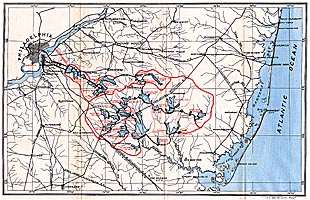
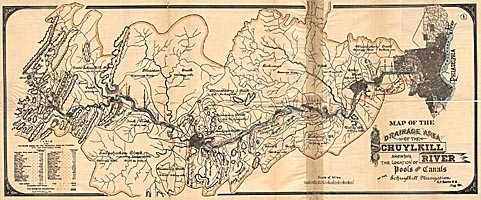
The city's delay in providing safe drinking water led to a number of
proposals by
private companies to supply safe drinking water to Philadelphia.
(Both maps from PWD Historical Collection)
1. Left: In 1891, Joseph Wharton proposed to build a system of
reservoirs in the southern New Jersey Pine Barrens, with an aqueduct to
carry the water under the Delaware River into the city. Much of this land
is now protected in the Wharton State Forest.
(CLICK
HERE to view a report that describes the water supply plan associated
with this map.)
2. Right: An 1891 plan from the Schuylkill Navigation
Company proposed to carry Schuylkill water to the city via an aqueduct
(marked in red on map) beginning above Norristown, where the water was
presumably cleaner.
(CLICK
HERE to view a report and other plans that fully describe the
water supply plan associated with this map.)
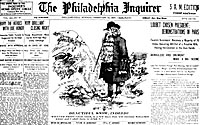
(PWD Historical Collection; edited from scan of photocopy
of microfilm)
In this 1899 cartoon published in The Philadelphia Inquirer
after a deep February snowfall, William Penn laments
that all this beautiful snow will eventually melt and become part of the
city's disease-laden water supply.
4. The Solution: Slow Sand Filtration
Scientists had known for years that contaminated water, when filtered through soil, would be cleansed of some contaminants and rendered more drinkable. Using this knowledge, engineers in the 19th century developed sand filters to remove impurities from drinking water. They discovered that a properly designed and maintained "slow sand" filter, through which water flows continuously by gravity, will trap disease-causing bacteria and other contaminants. European cities were the first to install sand filters for their water supplies, and generally suffered lower rates of typhoid fever and other water-borne diseases than cities with unfiltered supplies. By the time Philadelphia began building its water filtration plants in the first years of the 20th century, the benefits of such systems had long been proven elsewhere.
Between 1900 and 1911, Philadelphia built a system of five sand filtration plants on high ground along the Delaware and Schuylkill rivers, near the city's upstream boundaries (to access the cleanest water within city limits). High ground was preferred because gravity flow was more cost-effective than pumping, but even so, to get water to the highest parts of the city, a new reservoir in Oak Lane and five high-service pumping stations also had to be constructed. A new pumping station was also constructed at Lardner's Point, to take water from Torresdale and distribute it to reservoirs throughout the city.
Costing $28 million, the filtration system was the largest public works project in the city up to that time and the largest filtration works in the world. The project required the construction of transmission mains up to 6 feet in diameter, and many miles of new distribution mains, all designed to interconnect the city's formerly separate water distribution districts and to ensure the reliable delivery of safe, filtered water to every building in the City.
The filtration plants at Upper and Lower Roxborough were completed in 1902, at Belmont in 1904, and at Torresdale in 1909. Early that year, a key interconnection within the distribution system finally allowed filtered water from Torresdale to reach parts of the City previously without it. For the first time, on March 1, 1909, every Philadelphian living or working in a building with city water service received filtered water. The Queen Lane Filters, a late addition to the filtration scheme and not completed until 1911, provided additional capacity to serve the city's still-growing population. Absent from the plans was the addition of filters to several older pumping stations, including the Spring Garden and Fairmount Water Works, which were taken out of service in 1909.
As evidenced by the now-negligible death rates from typhoid and other water-borne
diseases, this system has served Philadelphians well for the past 100 years.
Water filtration accomplished what its advocates of a century ago predicted,
saving many lives and improving the overall health of the city.
Captions and Illustrations for Section 4
(All images from PWD Historical Collection)

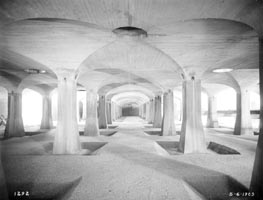
Two views of the Upper Roxborough Filters.
Top: Panoramic view of filter beds under construction on July 16, 1902.
Below: Finished vaulted concrete work on May 6, 1903, with beds of
filter sand in place.
These filters began operation on August 6, 1903.
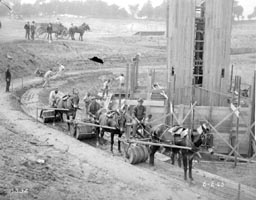
Sedimentation basin for the Belmont Filters, under construction, June 2, 1903.
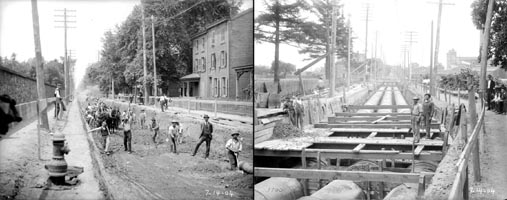
Two views taken July 14, 1904, of the triple-barrel pipeline construction
on State Road.
Many miles of large pipelines were built to connect the new filter plants
with the
existing water distribution system, extending filtered water service to all
areas of the city.
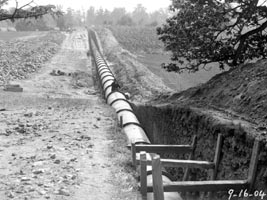

Two view of water mains
Left: A rural view, with a large pipeline running through farmland,
from Oak Lane Reservoir toward Tabor Road, September 16, 1904.
Right: Pipeline under construction in Cumberland Street west of 13th
Street, May 15, 1907.

A work gang plugging leaks in the 10'7" diameter Torresdale Conduit,
December 18, 1906.
This massive pipeline, 2.5 miles long, was built to carry filtered water
from the Torresdale Filters to the Lardner's Point Pumping Station. Both
the filters and the pumping station were the largest of their kind in
the world when they were built.
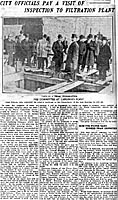
Newspaper report on inspection visit made by city officials to Torresdale
and Lardner's Point, Philadelphia Press, November 15, 1906.
Delays plagued the completion of the Torresdale filters and conduit, which
were not in full operation until 1909.
5. Environmental Challenges in the 21st Century
With the completion of Philadelphia's water filtration system in 1911, water-borne diseases such as typhoid fever gradually disappeared from the city. However, because the bacteria could always be re-introduced to the city by travelers from other countries where typhoid fever still flourishes, the Philadelphia Water Department continues to operate the City's three modern water treatment plants with vigilance to keep the City's drinking water safe. A chemist monitors water quality at each of the treatment plants 24 hours per day, every day.
Today, the treatment plants provide three barriers against disease: disinfection with sodium hypochlorite; gravity settling enhanced with chemical coagulants; and filtration through sand and crushed coal. Treatment of sewage before it enters our streams, a process which also includes disinfection, reduces the risk that disease-causing organisms will be present in the City's water supply.
By building water filtration plants that rendered polluted river water safe to drink (if not always palatable), Philadelphia put off the need to remove pollutants entering the rivers from household and industrial sewage. Enhancements to the water treatment process were added to the filtration plants in the 1950s. A comprehensive plan for collection and treatment of the city's sewage, developed in 1914, was also fully realized in the 1950s. While the city's first sewage treatment plants removed about half of the pollutants in the waste stream, upgrades made in the 1970s and 1980s remove up to 95% of the pollutants, producing effluents that are as clean as, or cleaner than, the river water itself.
With the city's third century of public water supply underway, the Philadelphia Water Department continues to use the best science and engineering available to ensure that the city's drinking water meets all national, state, and local standards for drinking water quality while protecting our environment and making Philadelphia a healthier city. The Department's scientists and engineers continue to monitor and improve the water supply. They are implementing innovative ways to prevent pollutants from entering our water sources, simultaneously conducting research to find new means of removing extremely small concentrations of contaminants from the drinking water.
Captions and Illustrations for Section
5
(All images from PWD Historical Collection)
This chart tracks the death rates in the city due to typhoid fever from the Civil War to the years before World War II. The death rate (rather than number of actual deaths) is considered a more accurate reflection of the incidence of disease, as it takes into account the total population. Note that typhoid cases spiked during the Civil War (1861-65), due to the large number of military hospitals in Philadelphia, and also during the 1876 Centennial Exhibition, due to the influx of millions of out-of-town visitors. After the completion of the city's water filtration plants, and the subsequent addition of chlorine to the filtered water before distribution, death rates plummeted, but the search for a solution had its cost. Between 1860 and the completion of the filtration system in 1909, 27,513 Philadelphians died of typhoid fever, and for each death from ten to fifteen people became sick but did not die.

1909 map showing Philadelphia's filtered drinking water system as it neared
completion

In this February 25, 1909 from the Philadelphia Press,William Penn,
anticipating the filtration of the entire
city water supply a few days later, gladly raises a glass of filtered water
to the departing devil,
whose suitcase reeks with the germs of typhoid, diphtheria and scarlet fever.
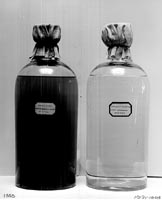
Bottles Containing Water from Upper Roxborough, October 21, 1903.
As this photograph of raw river water and filtered drinking water clearly
shows, the filtration system
removed visible impurities, such as coal dust and mud, along with the more
dangerous bacteria, which were invisible to the naked eye.
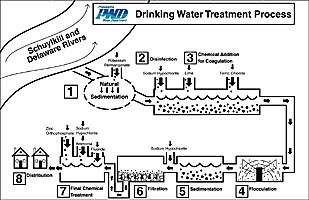
This diagram shows the many steps the Philadelphia Water Department takes
to
safeguard the drinking water delivered to its customers.
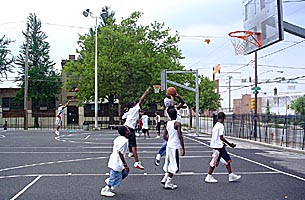
The porous paving on this basketball court, in the city's Mill Creek neighborhood,
allows stormwater to filter into
the ground rather than run off into the sewer and, ultimately, the Schuylkill
River. It is just one small example of
an ongoing effort by the city to keep pollutants out of drinking water supplies.
EXHIBIT CREDITS
Exhibit created by
C. Drew Brown, PWD Manager of Public Education
Adam Levine, PWD Historical Consultant
and Ellen Freedman Schultz, PWD Education Consultant.
Exhibit panels designed by Amy Blake/BBDG.
Unless otherwise noted, all images are from the Philadelphia Water Department.
Thanks to the following institutions and individuals for providing
images and information:
Library of The College of Physicians of Philadelphia
Free Library of Philadelphia
Germantown Historical Society
Center for the Study of the History of Nursing, University of Pennsylvania
Curatorial Department, The Franklin Institute Inc., Philadelphia, PA
University of Pennsylvania Archives
Philadelphia City Archives
Library Company of Philadelphia
Library of Congress
Anita Guevara
Adam Levine
Michael P. McCarthy's 1987 book,
Typhoid and the Politics of Public Health in 19th Century Philadelphia,
proved invaluable in preparing the exhibit text.
Page last modified June 18, 2011
Website by Panacea Design
and Adam Levine
